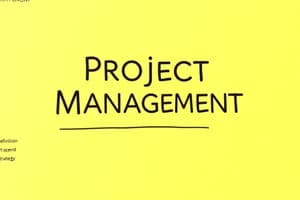Podcast
Questions and Answers
What is the purpose of scope definition in project planning?
What is the purpose of scope definition in project planning?
- To coordinate with stakeholders
- To select the project team members
- To identify the project's goals, deliverables, and boundaries (correct)
- To decide on the project budget
How does a well-defined scope help in cost control?
How does a well-defined scope help in cost control?
- By managing expectations of the project team
- By helping estimate costs more accurately (correct)
- By allowing for unnecessary distractions
- By making stakeholders understand the project better
Which aspect of project planning directly benefits from a realistic project schedule and milestone plan derived from a clear scope?
Which aspect of project planning directly benefits from a realistic project schedule and milestone plan derived from a clear scope?
- Quality control
- Risk management
- Timeline management (correct)
- Resource allocation
In project planning, how does scope definition contribute to change management?
In project planning, how does scope definition contribute to change management?
What is the primary benefit of a well-defined scope for the project team?
What is the primary benefit of a well-defined scope for the project team?
What is the first step in the scope definition process?
What is the first step in the scope definition process?
What is one of the common challenges in scope definition mentioned?
What is one of the common challenges in scope definition mentioned?
How can scope creep be described?
How can scope creep be described?
What is a recommended best practice for scope definition?
What is a recommended best practice for scope definition?
Why is it important to manage changes in scope definitions?
Why is it important to manage changes in scope definitions?
Flashcards are hidden until you start studying
Study Notes
Project Planning: Defining the Scope
Project planning is the blueprint that guides your team towards a successful outcome. It's a structured process that helps you stay on track, overcome challenges, and deliver within the agreed-upon timeline and budget. One crucial aspect of project planning is defining the scope, which lays the foundation for all subsequent decisions and actions.
What is Scope Definition?
Scope definition is the process of delineating exactly what a project entails. It identifies the project's goals, deliverables, and boundaries. A well-defined scope helps you estimate time and cost, manage expectations, and ensure that the project remains focused on its primary objectives.
Importance of Scope Definition
-
Clarity: A clear scope helps stakeholders, the project team, and other project members understand the project's objectives and what's expected of them.
-
Focus: A well-defined scope keeps the project team focused on what's important, allowing them to avoid unnecessary distractions.
-
Cost Control: Because scope definition helps you understand the project's deliverables, it allows you to estimate costs more accurately and objectively.
-
Timeline: A clear scope can help you develop a realistic project schedule and milestone plan.
-
Change Management: A well-defined scope provides a benchmark for change control, allowing you to evaluate and approve changes based on their impact on the project's objectives and deliverables.
Scope Definition Process
-
Identify the project goals and objectives: Start by understanding the project's purpose and the desired outcomes. This will help you define the scope in terms of what you want to achieve, rather than focusing on the tasks or deliverables alone.
-
Analyze the stakeholder needs and expectations: Understand the requirements and expectations of all stakeholders involved in the project, including customers, sponsors, and project team members.
-
Define the project scope: Use the information gathered from steps 1 and 2 to create a detailed, written scope statement that outlines the project's boundaries, deliverables, and objectives.
-
Create a work breakdown structure (WBS): Break down the project into smaller, manageable components, and map out the work that needs to be accomplished.
-
Estimate costs and develop a project schedule: Use the WBS to estimate costs and develop a project schedule and milestone plan.
-
Manage changes: Ensure that any changes to the project's scope, deliverables, or objectives are evaluated and approved according to your change management plan.
Common Scope Definition Challenges
-
Scope creep: Scope creep is the gradual expansion of a project's scope, often due to unclear or changing requirements.
-
Lack of stakeholder engagement: Failure to involve stakeholders in the scope definition process may result in missing important requirements or expectations.
-
Inaccurate or incomplete information: Inaccurate or incomplete information can lead to an inadequate scope definition, resulting in cost overruns, schedule delays, and poor outcomes.
Best Practices for Scope Definition
-
Involve stakeholders: Ensure that all stakeholders are involved in the scope definition process, including customers, sponsors, and project team members.
-
Create a clear and concise scope statement: Use plain language and avoid technical jargon.
-
Break down the project into smaller, manageable components: Use a work breakdown structure (WBS) to organize the project's work and deliverables.
-
Estimate costs and develop a project schedule: Use the WBS to estimate costs and develop a project schedule and milestone plan.
-
Manage changes: Establish a change management process to ensure that any changes to the project's scope, deliverables, or objectives are evaluated and approved according to your change management plan.
By following these best practices, you can ensure that your project planning efforts result in a clear, well-defined scope that helps you deliver successful projects. Remember, a well-defined scope is the foundation for all subsequent project management decisions and actions, so make sure that you invest the time and effort required to get it right.
Studying That Suits You
Use AI to generate personalized quizzes and flashcards to suit your learning preferences.




